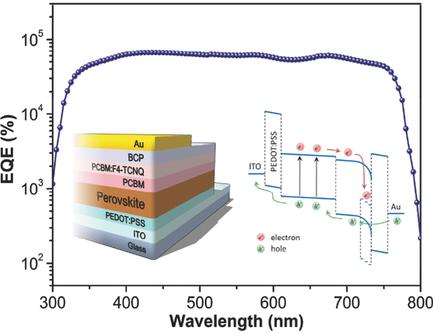当前位置:
X-MOL 学术
›
Adv. Opt. Mater.
›
论文详情
Our official English website, www.x-mol.net, welcomes your
feedback! (Note: you will need to create a separate account there.)
Trapped‐Electron‐Induced Hole Injection in Perovskite Photodetector with Controllable Gain
Advanced Optical Materials ( IF 8.0 ) Pub Date : 2018-01-09 , DOI: 10.1002/adom.201701189 Dezhong Zhang 1 , Chunyu Liu 1 , Kanzhe Li 2 , Wenbin Guo 2 , Fengli Gao 2 , Jingran Zhou 1 , Xindong Zhang 2 , Shengping Ruan 1
Advanced Optical Materials ( IF 8.0 ) Pub Date : 2018-01-09 , DOI: 10.1002/adom.201701189 Dezhong Zhang 1 , Chunyu Liu 1 , Kanzhe Li 2 , Wenbin Guo 2 , Fengli Gao 2 , Jingran Zhou 1 , Xindong Zhang 2 , Shengping Ruan 1
Affiliation

|
Perovskite is an excellent photosensitive material but it exhibits a shortcoming in providing photoconductive gain for layered photodetectors due to lacking of trap states. Here, the perovskite photodetectors are fabricated with controllable photoconductive gain by designing a trapped‐electron‐induced hole injection structure of [6,6]‐phenyl‐C61‐butyric acid methyl ester (PCBM):2,3,5,6‐tetrafluoro‐7,7,8,8‐tetracyanoquinodimethane (F4‐TCNQ)/Bathocuproine/Au. The deep trap states provided by F4‐TCNQ can capture the photogenerated electrons from perovskite, which makes the hole injection barrier thin enough to be tunneled through, allowing the hole injection and forming a gain. Meanwhile, the gain is controllable by adjusting the electron trapping and hole transport capacities of PCBM:F4‐TCNQ dual‐functional layer, concomitantly realizing the transition of device from photovoltaic to photoconductive. Thus fabricated device achieves a higher external quantum efficiency of 6 × 104% at a lower bias of −1 V, and simultaneously maintains the rectifying behavior in dark, providing the detectivity of about 1 × 1015 Jones.
中文翻译:

具有可控制增益的钙钛矿光电探测器中的陷获电子诱导空穴注入
钙钛矿是一种出色的光敏材料,但由于缺乏陷阱态,因此在为层状光电探测器提供光电导增益方面存在不足。在这里,钙钛矿光电探测器通过设计[6,6]-苯基-C 61的俘获电子诱导的空穴注入结构来制造,具有可控的光电导增益。丁酸甲酯(PCBM):2,3,5,6-四氟-7,7,8,8-四氰基喹二甲烷(F4-TCNQ)/ Bathocuproine / Au。F4-TCNQ提供的深陷阱状态可以捕获钙钛矿中的光生电子,这使空穴注入势垒足够薄,可以隧穿通过,从而允许空穴注入并形成增益。同时,可通过调节PCBM:F4-TCNQ双功能层的电子俘获和空穴传输能力来控制增益,从而实现器件从光伏到光电导的过渡。这样制成的器件在-1 V的较低偏置下可获得6×10 4%的较高外部量子效率,并同时在黑暗中保持整流性能,从而提供约1×10 15 Jones的检测率。
更新日期:2018-01-09
中文翻译:

具有可控制增益的钙钛矿光电探测器中的陷获电子诱导空穴注入
钙钛矿是一种出色的光敏材料,但由于缺乏陷阱态,因此在为层状光电探测器提供光电导增益方面存在不足。在这里,钙钛矿光电探测器通过设计[6,6]-苯基-C 61的俘获电子诱导的空穴注入结构来制造,具有可控的光电导增益。丁酸甲酯(PCBM):2,3,5,6-四氟-7,7,8,8-四氰基喹二甲烷(F4-TCNQ)/ Bathocuproine / Au。F4-TCNQ提供的深陷阱状态可以捕获钙钛矿中的光生电子,这使空穴注入势垒足够薄,可以隧穿通过,从而允许空穴注入并形成增益。同时,可通过调节PCBM:F4-TCNQ双功能层的电子俘获和空穴传输能力来控制增益,从而实现器件从光伏到光电导的过渡。这样制成的器件在-1 V的较低偏置下可获得6×10 4%的较高外部量子效率,并同时在黑暗中保持整流性能,从而提供约1×10 15 Jones的检测率。











































 京公网安备 11010802027423号
京公网安备 11010802027423号